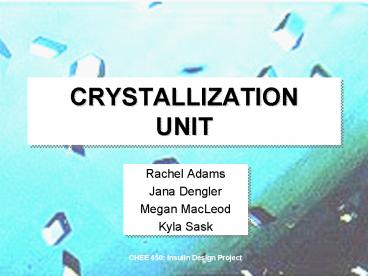CRYSTALLIZATION UNIT - PowerPoint PPT Presentation
1 / 31
Title:
CRYSTALLIZATION UNIT
Description:
Kyla Sask. CRYSTALLIZATION UNIT. Outline. Purpose of Crystallizer. Methods of Crystallization ... One of the final treatment steps in the purification and ... – PowerPoint PPT presentation
Number of Views:7233
Avg rating:5.0/5.0
Title: CRYSTALLIZATION UNIT
1
CRYSTALLIZATIONUNIT
- Rachel Adams
- Jana Dengler
- Megan MacLeod
- Kyla Sask
2
Outline
- Purpose of Crystallizer
- Methods of Crystallization
- Design Specifications
- Engineering Drawing
- Alternative Cost and Suppliers
- Alternative Processes
- Questions
3
Purpose of Crystallizer
- Used to recover pure solids from solution
- Highly desirable end product because of
- Exceptional purity
- Ease of handling
- Long shelf life
- One of the final treatment steps in the
purification and concentration of insulin - 98 of the insulin must be crystallized
4
Mechanism of Crystallization
- Crystal nucleation and amorphous precipitates are
in competition during supersaturation conditions - Nucleation favored by slowly exceeding the
equilibrium point of saturation - permits time for the protein structure
- to orient in a crystalline lattice
5
Continuous or Batch Design
- Benefits of Continuous
- Can maintain solution in supersaturated state
- Large fluidized bed for crystallization
- Minimizes operation costs
- Minimize down time (startup and shutdown)
- Benefits of Batch
- Good when have low concentration of product, high
viscosity or many impurities - Can produce high quality crystal
6
Methods of Crystallization
- Supersaturation liquid (solvent) contains more
dissolved solids (solute) than can ordinarily be
accommodated at that temperature - Can be achieved by several methods
- Cooling
- Evaporation
- Solvent addition
- Precipitant Addition
7
Cooling Method
- Concentrated solution gradually cooled below
saturation temperature (50-60C) to generate a
supersaturated state - Yields well defined micron-sized crystals
- Shell and tube heat exchanger is used to cool
solution
8
Cooling Method
- Advantages
- High purity downstream
- Disadvantages
- Temperature change does not always have a
positive effect on supersaturation in proteins - Protein stability may be at risk
- Solubility can be relatively insensitive to
temperature at high salt concentrations - Cooling will only help reach supersaturation in
systems where solubility and temperature are
directly related
9
Evaporation Method
- Solute dissolves in solution when heated to a
certain temperature (75C) - Slowly cooled until crystals precipitate
- Shell and tube heat exchanger is used to heat and
cool solution
10
Evaporation Method
- Advantages
- high purity levels downstream
- Disadvantages
- Vaporization chamber requires high pressures
- Protein viability very sensitive to high
temperatures
11
Solvent Method
- Solvents are generally good protein precipitants
- Their low dielectric constants lower the
solvating power of their aqueous solutions - Requires acidic solvent
- For crystallization, an insulin protein falls
out of solution at isoelectric point
pH 5.4-5.7
12
Solvent Method
- Advantages
- Proteins viability not at risk due to temperature
change - Disadvantages
- Possible protein contamination due to
insufficient downstream solvent recovery
13
Addition of Zinc Ions
- In the presence of zinc ions, insulin proteins
orient to form hexamer structures - Zinc ions render insulin insoluble which results
in micro-crystallization and precipitation - Human Insulin Hexamer with Zinc ion
14
Seeding Techniques
- Primary nucleation is the first step in
crystallization - growth of a new crystal - Can bypass primary nucleation (creation of new
crystals) by "seeding" the solution - Secondary nucleation is crystal growth initiated
by contact - Accelerated by "seeding" adding existing insulin
crystals to perpetuate crystal growth
15
Progression of Crystallization
http//www.cheresources.com/cryst.shtml
16
Crystal Size and Growth Rate
- Crystal size distribution is important for the
production process affects - downstream processing
- solids transport
- caking and storage properties of the material
- Correct crystal size vital for economic
production - Crystals produced in commercial crystallization
processes are usually small - 30 to 100 um in diameter
17
Crystal Size and Growth Rate
- Assumptions
- Continuous
- Constant-volume
- Isothermal
- Well-mixed
- Relates population density and crystal size
- Mechanism of crystal growth to determine crystal
growth
18
Crystallizer Design
- Addition of acidic solvent to decrease pH to
achieve supersaturation - Addition of Zinc ions to initiate Insulin
precipitation - Implementing of seeding technique
- Minimize heat variation to maintain protein
stability - Washing and extensive solvent recovery downstream
19
Design Equations
20
Proposed Design
21
Engineering Drawing
http//sundoc.bibliothek.uni-halle.de/diss-online/
04/04H181/prom.pdf
22
Costing Estimates
- Three costs involved
- Crystallizer unit
- Zinc Chloride Solution and Water
- Power Requirements
23
Costing Estimates
- Crystallizer Unit www.matche.com
24
Costing Estimates
- Crystallizer Unit
25
Costing Estimates
- Zinc Chloride Solution
- Many suppliers
- 15.00 - 27.00 for 500g
- Power Requirements
- Canadian Hydro 8.99 cents/kWh (April, 2006)
26
Crystallizer Suppliers
- GEA Niro Inc.
- Companies in over 50 countries
- Copenhagen, Columbia, Germany, USA
- GEA Kestner Evaporator/Crystallizer
- Swenson Technology Inc.
- Illinois, USA
- HPD Inc.
- Illinois, USA
27
Alternative Processes
- For special drug purposes and when a zinc-free
product is needed - Alternative processes that can be used include
- Isoelectric Precipitation
- Gel Chromatography
- Ultrafiltration
28
Isoelectric Precipitation
- Protein purification procedure that
can be used with
crystallization
or on its own - The pH of a mixture is adjusted to the pI of the
protein to be isolated to selectively minimize
its solubility
29
Gel Filtration Chromatography
- Molecules are separated according to their size
and shape - Filtration column is filled with porous beads
- Solution passes through column
- Elution through the gel occurs in order of
decreasing molecular masses
30
Ultrafiltration
- Ultrafiltration used to concentrate
macromolecular solutions - Forced under pressure or by centrifugation
through a semipermeable membranous disk - Solvent and small solutes pass
- through the membrane, leaving
- behind a more concentrated
- macromolecular solution
31
- QUESTIONS?































